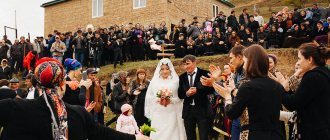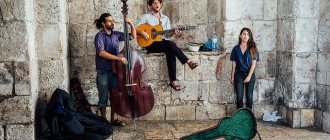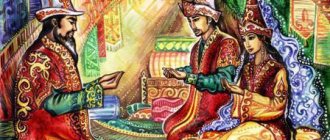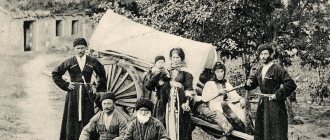The Yazidis are a subethnic group of the Kurds. During the First World War they fought with the Ottoman Empire on the side of the Russian Empire. It is noteworthy that during this period, many Muslim Kurds were active participants in the genocide of Assyrians and Armenians on the side of Turkey. Since ancient times, the people were oppressed by Muslims, who considered them “infidels.” Since 2014, the terrorist organization “Islamic State of Iraq and the Levant” (banned in the Russian Federation) began genocide against the people in Iraq. In Armenia, the Yazidi community began to form from 1877 to 1878, during the Russian-Turkish War.
The people have organizations, the most famous of which are the socio-political party “Yezidkhana” and the National Union of Yazidis. The activities of the union are largely aimed at the cultural and educational life of the people. The Yezidkhana Party is the only party in the world founded by Yazidis. Its activities are aimed at uniting the representatives of the people, preserving their national identity, the spiritual and moral character of the Yezidis, political cohesion, preserving love, devotion to the behests of their ancestors, protecting the political and civil rights of the representatives of the people. The party complies with democratic principles, values, ideals, it has its own charter and program, in accordance with which it acts. Yezidkhana attaches great importance to education, especially the national school. The party has developed plans aimed at developing and preserving national culture and traditions. Cooperation has been established with all organizations advocating the protection of freedom and constitutional rights of national minorities.
Where live
The people live mainly in the north of Iraq in Iraqi Kurdistan and European countries. They live in communities in the villages of the regions of Aragatsotn, Ararat, Shirak, and the cities of Yerevan, Abovyan, Vanadzor, Tashir, Dilijan. The people migrated to the east of Armenia in the thousands, where they settled in the regions of Aparan, Surmalu, Talin, Ashtarak, Etchmiadzin, Armavir. During World War I, the Armenian genocide, even greater migration occurred. The Yezidis fled from the provinces of Kars, Van, Surmalu and also settled in the regions of eastern Armenia. Officially, Yazidi societies are registered in Turkey, Armenia, Russia, and Georgia.
Yazidi wedding: traditions and customs, photos. Yazidi wedding - a tribute to traditions
Yazidi weddings begin very early in the morning at the groom's house. It is customary to invite musicians to his home. The newlyweds invite their best friends and people who live in the neighborhood to their celebration. The presence of the closest relatives of both parties is considered mandatory. At noon, the relatives, who automatically become the groom's confidants, go to his future wife. A table with refreshments is set up in the girl’s yard for welcome guests. They will be treated to drinks, delicious food, and desserts. When the young man's relatives reach the desired place, they say words of congratulations, drink and eat.
Women invited to the holiday present gifts to the bride on large round trays. Presents need to be beautifully packaged, tied with ribbons of different colors and carefully placed on trays. It is best to pack them in transparent film. There should be a total of five trays with gifts - this is considered mandatory. The gifts include two mandatory gifts. This is an elegant wedding dress for the hero of the occasion and a red shawl. Sweets, champagne and other small items are placed on other trays, which the girl’s relatives gladly take.
The bride's closest relatives deal with the gifts, while musicians play cheerful music. Then the close girls should give gifts to the groom's confidants. In order for the bride to cross the threshold of her home, relatives of both parties must dance a dance called “govand”. This is a very fun and original dance. Only after this the bride’s relatives allow guests to enter the house.
The owners of the house must show all the gifts that the bride received earlier. The guests examine them carefully. When words of gratitude are said, the bride's relatives present the groom with a surprise. Usually a wedding ring is chosen as a gift. The groom will wear it for the rest of his life. When the young man accepts this gift, the bride’s relatives begin to show the guests her dowry. Then the young man's relatives take the dowry to his house. It will await the arrival of the newlyweds there. It takes a long time to collect a dowry for a bride, because it consists of things that the newlyweds will need in their future family life. The most important thing is that there are warm blankets, pillows, and bed linen.
Before the meal begins, several rituals must be performed. The shawl that the girl has and the shawl that her future husband gave her as a gift are tied together. The bride must wear this makeshift outfit. She has no right to remove the knitted shawls before this solemn day ends. The meal itself lasts approximately three hours. The girl will leave her home only after her relatives have performed several important rituals. First, the bride's brother must tie and untie a ribbon around the young girl's waist. This must be done three times. Secondly, the groom is obliged to give the relatives of his future wife a ransom for her pillow. If he copes with this task, then the girl is released from her home. Then everyone heads to the young man's house. The ride is accompanied by a cheerful melody played by musicians.
The newlyweds will not enter the house until the future mother-in-law of the bride showers them with candies and cookies. She keeps sweets on a large tray. The young man then stands on a step or other elevated position to place the apple on his future bride's head. It is a symbol of fertility and a sign to multiply.
Before the newly-made spouses cross the threshold of the groom's house, pita bread is placed on their shoulders. This is a symbol of wealth and prosperity. It is believed that a young family will never experience financial difficulties. Upon entering the house, the bride and groom are given a plate. They must kick the utensils at the same time. If the groom breaks it, their firstborn will be a boy. If a girl breaks the plate, then the couple will have a baby first. Young girls and boys must collect all the fragments that remain from the broken dishes.
Each Yazidi wedding ceremony should be accompanied by a cheerful melody. Women should not sit with men at the wedding table. In order for the wedding ceremony to take place correctly, a toastmaster is invited to the celebration. The presenter will monitor whether traditions and rituals are observed.
At her wedding in the Armenian village of Mushakan, 15-year-old Sona Amoyan stands barefoot on the cold floor for half an hour as wedding guests walk past her.
Scenes from the wedding of Omar and Sona Amoyan.
Traditions in the Yazidi community dictate that she cannot talk, sit or eat in the presence of her in-laws.
Sona met her fiancé, 16-year-old Omar, at her wedding.
After marriage, she will stop going to school and move to live with his family.
“A married woman is ashamed to go to school,” Sona’s mother explained. “Besides, what young man would want his wife to go to school?”
Sona's story is common among young Yazidi women in Armenia, who typically leave school at age 14 to prepare for marriage. Boys study a little longer and leave school to become shepherds. This is the traditional occupation of the Yazidis in Armenia.
Activists warn the customs risk marginalizing another generation of Yazidi women, but traditionalists say the marriage of young girls is an ancient tradition.
“This is a generally accepted law, and this is how it will continue. If the girl is mature, then I am for her to be married at 16,” said the chairman of the National Union of Yazidis, Aziz Tamoyan.
Even if mothers are unhappy that their daughters are repeating their fate, they say that they are unable to resist tradition.
According to 38-year-old Lilia Avdoyan, who attended the wedding, she dreamed of becoming a doctor. However, when she was 16 years old, her grandfather forced her to quit school and get married. Now the same fate awaits her 14-year-old daughter.
“My husband forced our daughter to drop out of school, and I was powerless here,” she said. “Children often complain that they have to leave and live with another family. They are still too young and everything falls on their shoulders,” she continued.
“Teachers in Armenian schools often try to convince parents of Yazidi children to come to their senses and not force their children to leave school, or at least postpone it for a while. However, parents always have memorized answers ready, such as: “my child is sick” or “he is not doing well in school and does not want to study,” Avdoyan added.
The Yazidis are a close-knit community that practices a unique religion and speaks a dialect of the Kurdish language. In Armenia they are a growing community in which families have 8-10 children.
According to the 2001 census, there are about 40,000 thousand Yazidis in Armenia, which is just over 1% of the total population of Armenia, however, according to Tamoyan, their number has reached 60,000.
At the wedding, Sona stands and waits for the guests to look at her dowry. Omar will be able to enter the room only after this. Before leaving to celebrate with other men, he places a ring on her finger. However, he manages to forbid the women gathered around his new wife not to do her makeup.
“A woman cannot use cosmetics or shop without her husband’s permission,” Avdoyan said. “She cannot make a toast, talk in front of her father-in-law, study or work.”
The example of 23-year-old Inessa is proof that not all Yazidi parents adhere to traditional views.
She has a university degree and said her mother and father supported her desire to pursue an education. She said she also advises others to at least finish school, but added that it is impossible to change the views of families who adhere to old traditions.
Taking advantage of the moment when Omar's relatives left the room, Sona sat down to rest for a while. Then she will go to her husband's house in the village of Mkhchyan.
As they drive away, Omar looks out the limousine window, shouting to the bride's neighbors, "We're taking the girl off your street!"
In Mkhchyan, before entering his house, Omar climbs onto the roof and tries to hit his wife's head with a red apple, but misses. The ritual is intended to ensure that the life together is happy and the wife is submissive.
One of those present, Arif, said that after his wedding, he threw an apple so hard that his 14-year-old wife fainted and her nose began to bleed.
“They gave her water, but she came to her senses only after 15-20 minutes,” he recalled. “Why should I feel guilty? Law is law. You need to hit the head with an apple. This is our custom. Even now, for example, when my wife does not listen to me, or when I ask for a glass of water and she hesitates, I hit her,” he continued.
Next year, 33-year-old Arif will become a grandfather.
Anush Poghosyan, who works at the Women's Resource Center in Yerevan, said early marriage is a "vice" in the Yazidi community but it is very difficult to do anything about it. She doesn't remember Yazidi women ever turning to them for help.
“Marriage between teenagers is a violation of a number of rights,” she explained. “In particular, the right to control one’s own body, since very often in adolescence girls are not physically or psychologically ready for sexual relations.”
“Marriage during adolescence also violates the right to free choice,” she continued. “A teenager cannot make an informed decision, and very often parents do not take into account the opinions of their children and force them to get married.”
Ethnographer Hranush Kharatyan, who studies the history of the Yazidis, said changes in Yazidi customs are unlikely.
“Yazidis are a fundamentally closed society,” she said. “Their traditions are the most important symbol for preserving their ethnicity, which is ancient and changes very slowly. But elements of prestige, for example, the fact that the bride is picked up from a wedding in a limousine, have become part of their customs and coexist with the old traditions without changing them.”
After arriving at her new home, Sona stands in the center of the living room and awaits the next part of the ceremony, during which her mother-in-law will give her a gold ornament.
Only then will she finally be able to sit down.
Lusine Avakyan, independent journalist.
Not long ago I managed to attend a Kurdish wedding in Syria, and Kurds who profess not Islam, but Yazidism, so going to this wedding was especially interesting for me. Of course, I have seen many weddings in the Arab world - both Christian and Muslim, but until now I had not been to a Yazidi wedding.
The Yazidi religion is close to the beliefs of other originally pre-Islamic Kurdish religions. Based mainly on oral tradition. There are also two sacred books outlining dogma, canons, cosmogony and rituals: “The Book of Revelation” and “The Black Book”.
Due to constant persecution, the Yazidi religion is closed and poorly studied. Their creed, whose reformer was Sheikh Adi ibn Musafir (d. 1160 or 1162), was finally formed by the 14th-15th centuries, having absorbed elements of Zoroastrianism, Judaism, Christianity, and Islam.
Muslim and Christian critics of Yazidism associated the supreme angel Malak-Tavusi (the Peacock Angel), revered by the Yazidis, with a fallen angel, and therefore the Yazidis were mistakenly considered worshipers of an evil spirit. In reality, the Yazidis recognize one Creator God, Malak Tawus and Sheikh Adi. The groom Osman lives in Aleppo, the largest Syrian city after the capital, located in the north of the country. And we drove more than an hour to pick up the bride from her house to the small town of Afrin, closer to the Turkish border.
I was surprised by the following circumstance at this wedding: despite the fact that among the guests there were not only Kurds, but also Arabs, the wedding took place entirely in the Kurdish language. The toastmaster spoke exclusively Kurdish, there was also no Arabic music or songs, even dance music was its own - Kurdish. True, the groom's relatives approached each table in the restaurant one by one and greeted all the guests, including in Arabic, if there were Arab guests at the table. A very unique dance was performed by the guests and newlyweds to incredibly languid, mournful music. They walked hand in hand in a circle, slowly moving their feet, making almost no other movements. This low-energy dance could be performed by guests of any age, so the circle of dancers was incredibly wide, including not only young people, but also elderly relatives of the couple who were already barely walking.
The groom's Arab friends all tried to turn this boring dance into a lively fiery Arab dabki with jumps and dashing twists, but they were not allowed to do so.
Another thing surprised me towards the end of our stay at the wedding, when we were getting ready to leave.
At this time, the waiters came to our table and put several jars of different sparkling water on the table. Having decided to drink from one, suddenly, instead of the sweet taste of Coca-Cola, I felt the bitter taste of beer in my mouth. Another can of Fanta, which I decided to check on this occasion, also contained beer.
Apparently, the owners, in order not to embarrass some religious guests, decided to disguise the alcoholic drinks in this way, but they didn’t even warn.
Although, I understood earlier that those who wished could refresh themselves at the wedding with something more serious than soda. Some of the guests were very cheerful and lively, although I think they were served not beer, but arak - grape vodka.
Here are some photos from this wedding:
The bride, in the company of the groom and relatives, gets into the car to go to the restaurant. Behind the groom, the future husband of the groom's sister dances to the beat of invited drummers. Their wedding is also just around the corner.
The groom dances a Kurdish dance with his future mother-in-law before getting into the car, where his bride is already waiting for him. Behind him, the bride's relatives crowded in front of the entrance to the bride's house decorated with flowers.
The groom’s smart nephew, who walked around very happy before the wedding, rubbed his hands, and when the groom asked him why he was so happy, he replied: “You get married today, in 9 months you will give birth to a child, and I will become an uncle.” Enlightened child.
The groom treats the bride to cake.
On the way to Aleppo, the groom's relatives invited us to another wedding, they said that it would be more interesting, because the bride's family would take more part in it, but here the bride's relatives had to leave the wedding celebration after two o'clock in the morning, this is their custom.
But, to tell the truth, I liked this wedding too. Of the entire series of Arab weddings I have seen with a huge number of guests, so as not to offend anyone, it took place in a more relaxed, homely and cozy atmosphere. The groom's relatives and the newlyweds themselves tried not to deprive everyone present of their attention, which is usually not possible at Arab weddings due to too many guests.
The Yazidis, or Ezdi, as they call themselves, are an ethno-national group whose ancestral home is the Iraqi province of Mosul. These people are one of the branches of ethnic Kurds. Before World War II, the Ezdi lived mainly in Iraq, but today close-knit groups of representatives of this nationality live in the Caucasus, Turkey, Iran, and the USA. The Yezidis are a friendly and well-organized, although small, people. They even have a chapter that unites Ezdi living in different parts of the world.
Yazidi weddings: historical traditions
Like all representatives of this ethnic group, the Yazidis love and know how to celebrate holidays. Whether it is the birth of a child, christening or any other family celebration, it is not complete without ancient rituals, dancing and national singing. One of the most colorful and vibrant customs is the wedding. For the Ezdi, the family is the main component of their life, so the birth of a new family is given a lot of attention, and the celebration dedicated to the wedding is celebrated on a grand scale. Yazidi weddings in Tambov, Connecticut, Baku or Istanbul are approximately the same. In some areas, Beshkertum is still in effect - a ritual according to which parents can agree on the wedding of even newborn children. However, not everyone adheres to traditions so carefully: a Yazidi wedding today is voluntary, and the young people themselves can make decisions about it. However, young people happily adhere to Shirani (an analogue of our matchmaking), when the groom's parents with gifts go to the bride's house to meet her family.
A few weeks later, the trip with gifts is repeated, but this time the parents are already discussing the details of the wedding. And Yazidi weddings contain many details. At dawn of the appointed day, their relatives gather in the homes of the newlyweds. The bride's friends set the table in anticipation of the groom, and his guests have fun until dinner, and only then they go to fetch the bride with songs, dances, and national music. In front of everyone, with their hands raised high, the older women carry at least five trays with Sani - gifts for the newlywed. The main place is occupied by the traditional red shawl - a symbol of purity and love. Since preparations for such a celebration begin at the moment of the birth of a child, Yazidi weddings amaze with their richness and scope. Having entered the bride's house and tasted the offered sweets, the groom's relatives dress the bride while listening to national singing.
While the elders are busy getting dressed, the bridesmaids show everyone the gifts brought by the groom, and her parents give gifts to the groom. After this, all together, the guests go to the groom’s house, without stopping for a minute to perform ritual and simply cheerful folk songs. Upon entering the groom's house, the mother-in-law ties the bride's old shawl in a knot with a new, just presented red shawl. This means that the bride has now become part of her new family.
Yazidi weddings: modernity
Today, celebrations are not quite the same as they used to be. Despite the fact that Yazidi weddings follow similar scenarios, they are, of course, different from one another. Firstly, the place of residence of the nationality leaves an imprint. Secondly, there are fewer and fewer people who remember national traditions in detail. And yet, Yazidi weddings are a very fun, touching and very national spectacle.
Who are the Yazidis?
Yazidis are an ethnic group within the Kurdish people. How and where the Yezidis came from is now unknown for certain; the same can be said about the meaning of the name of the ethnic group. Moreover, the word “Yazidis” is completely devoid of any etymology. What is known is that the Yazidis came from Mesopotamia and now live in small diasporas in most countries of the world. The largest Yazidi diasporas are those living in Armenia, Iraq, Turkey and some CIS countries. Smaller groups are found in America and Europe.
Surprisingly, the Yazidis managed to almost completely preserve their language, customs, traditions and ways of life since the founding of their nation and national identity. This fact makes the Yazidis one of the oldest peoples on planet Earth. The basis of the Yazidi culture is their religious practice - Yezidism, which was widespread in Mesopotamia in pre-Islamic times. With the advent of Islam, Yezidism was recognized as an objectionable religion and suffered in every possible way to be oppressed and persecuted. There have been repeated attempts to abolish, destroy, and reform it, so improvements and additions to this tradition were made regularly. It acquired its modern appearance only in the 14th – 15th centuries. Then it turned into a “patchwork quilt” of scraps of different faiths and religious movements. It can be assumed that it was precisely this heterogeneity of the religious views of the Yazidis that became the reason for the constant repression and persecution that other peoples inflicted on the Yazidis. But despite everything, this ethnic group has retained its identity, culture, and religion. Two books serve as the sacred scripture of the Yazidis: “The Book of Revelation” and “The Black Book”. Interestingly, with such a large flock scattered throughout the world, there is only one temple where the Yazidis can practice their faith.
The peculiarity of this people is that it is impossible to become part of it simply by accepting Yazidism. You have to be born a Yazidi. Moreover, a true Yazidi is only one who was born from a mother and father who belonged to this nationality. The Yazidis live in a caste society. There are only two castes: laity and clergy. Not a single person can move from one caste to another, that is, caste boundaries are absolutely impenetrable. Communication between representatives of different castes is also strictly prohibited. A person's status, determined by caste, is inherited. Thus, a child born into a clergy family automatically becomes a priest; for this he does not need to study or enter service anywhere. In every family, children are taught the norms and traditions of Yazidism. The father, uncle or grandfather, that is, the eldest man in the family, is responsible for this. Women are prohibited from instilling religiosity in their children. The status of women among the Yazidis is very unattractive: she has practically no rights and spends her life giving birth to children and working around the house. Although this is typical for all peoples who adhere to Islam.
We can talk about the Yazidi culture for a very long time. Let's just say that they celebrate all their holidays in full accordance with all traditions and customs, which go back to antiquity. Modern cultural trends do not influence them as strongly as other national cultures. Yazidis are required to pray frequently, and this is done according to caste laws. If this rule is not observed, all communication with the criminal is stopped and he is expelled from the community in disgrace. Let's say a few words about the traditional Yazidi wedding.
Yazidi wedding
Yazidi weddings still take place according to the rituals of their ancestors. Marriages between representatives of different castes are prohibited, so the bride and groom must belong to the same caste. The wedding celebration lasts for seven days. But now only the wealthiest families can afford such a feast, while the rest are limited to two days of the holiday. The morning of the first day of the holiday begins with noisy gunfire. This is how the men of the village drive away evil spirits so that they cannot prevent the young from creating a new prosperous family. In general, the Yazidis have several wedding celebration scenarios; the choice here depends on the wealth and prosperity of the families of the bride and groom. You can carry out a betrothal from the cradle, a simple betrothal, the abduction of the bride, or her voluntary departure to the house of her future husband. Sometimes the following is practiced: a young brother and sister from one family are married to a sister and brother from another. But much more common is the celebration of an ordinary traditional wedding, in which many interesting and spectacular rituals are performed. Only men are allowed to sit at the wedding table, while women, along with their young wives, painstakingly collect the bride's trousseau and then take her out to dance. After the wedding is over, the husband brings his wife to his home, and the normal daily life of the young family begins.
Name
There are three options for the origin of the ethnonym “Yezidi”:
- from the name of the city of Ezden in the ancient state of Adiabene;
- the people of Sultan Yezid, who had the nickname Red Yezid;
- Legend has it that the leader of the ancient Adabi people led his people across the Red Sea from ancient Nubia to Arabia. The people came to the country of Dilmun, where they founded the city of Sham. Based on another theory, Sultan Yezid took part in a battle with an unknown people, got very dirty with blood, for which he was called the Red Yazid, and the people whose country he conquered were called Yazidis.

Groom's preparations
A kavor—the imprisoned father—is appointed in advance. The ceremony of the groom's transition to family life takes place in his house. The future head of the family and his unmarried friend are placed back to back in a large basin. Water is poured over the backs as a sign of the separation of single life from family life. After the ceremony, the groom is dressed with dancing and singing. A bouquet of willow branches is decorated with ribbons and decorated with sweets, apples and pomegranates. At modern weddings, willow branches are often replaced with a sword. It is called “Arsaniki Tsar” - a symbol of well-being and prosperity in the future family.
Juicy fish in Asian style: preparing salmon in a new way
UK introduces new rules for travelers due to COVID
“Dalida”: a recipe for a beautiful cake for special occasions
Story
The ancestors of the Yazidis have lived in northern Iraq since ancient times. During the existence of the Ottoman Empire, they were forced to move to neighboring states to escape extermination and defend their freedom. The Muslim world subjected the people to persecution that lasted for centuries. Over 12 centuries, neighboring Islamic peoples attacked the Yazidis 72 times, committed genocide, and sought to destroy their culture and faith.
According to representatives of the nationality, for the last 1,000 years they have been forced to live with weapons in their hands, trying to preserve their religion. During this period, there were many battles in the areas where the Yazidis lived. The people consider the Arab invasion of the region to be the strongest blow. Islam brought enormous suffering to the people; many were then forced to accept this religion. In the 20th century, near the Iraqi city of Sulaymaniyah, archaeologists found a scroll that described in detail the Yazidis’ resistance to the invaders. In a few days, the enemy executed about 100,000 townspeople, who were Yezidis, Zoroastrians who refused to convert to Islam. Those who remained alive were captured or converted to Islam. They were used to attack and destroy the escaped Yazidis who were hiding in the high mountains.
Wedding preparations
The bride's house and the groom's house hold their own rituals. The girl bakes wedding bread, to which candied fruits and dried fruits are added. The cooking process is entrusted, depending on the territorial affiliation, to young boys and girls, or priests. Young people accompany the baking with songs, dances and games with flour. And the priest must cover his head and face with a cloth so as not to jinx the bride.

Relatives from the groom's side prepare meat for the wedding. The ritual of slaughtering the ox is undertaken by men. Moreover, they bought the calf for the ceremony while the guy was little. He is fattened and protected until the wedding. The bull is slaughtered on Friday; the groom strikes the first blow.
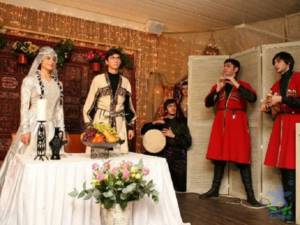
Language
The people speak Ezdiki, which is a dialect of the Kurdish Kurmanji language, which belongs to the Iranian group of the Aryan branch of the Indo-European family of languages. In the 11th century, the people had their own alphabet of 33 letters, which is not used today. Thanks to the initiative of academician Aziz Tamoyan and journalist Hasan Tamoyan, a new alphabet was created based on Latin and Russian letters. Today it publishes fiction books, textbooks, and newspapers. The Yazidis have a national school, and a radio program is broadcast daily in the Yazidi language.

Religion
The people profess a syncretic religion, Yezidism. It combines elements of Islam, Judaism, and Christianity. The Yazidis believe in the existence of one god, his seven angels, of which the most important is Malak Tavus, or “Jabrail,” depicted as a peacock. It is believed that the religion was founded by Sheikh Sharif Adi ibn Musafir, who lived in the 11th and 12th centuries. The Yezidis revered him as a prophet. They believed that he was an angel reborn in human form. The faith was finally formed in the 14th and 15th centuries.
The religion is similar to the beliefs of the Ali-Ilahs and Alevis, and is mostly based on oral tradition. There are 2 sacred books that set out the canons, dogmatics, cosmogony, and rituals:
- Book of revelation "Ketebe Jilve"
- Black book "Maskhafe Rash"
In addition to these books, there are other sources of teaching - religious hymns:
- kavly (kaul)
- beats
Along with jandil, dua, mishabat, duruz, they are the most important genre of prayer poetry. Singers and experts in hymns belong to the lower spiritual class, they are qawwals. Yazidi religious scriptures are written in the Kurmanji language. Muslim critics of the Yazidism religion often associate Malak Tawus with the fallen angel, or Iblis. Therefore, earlier and still today, the Yazidis were mistakenly considered worshipers of the evil spirit.
The main shrine of the people - the temple at the mausoleum of Sheikh Sharif Adi ibn Musafir in Lalish - is located 40 km from Mosul in northern Iraq. The main religious objects of the Yazidi believers are 7 bird figurines on a high stand (sanjak), cast in bronze. They are kept in Lalesh and are symbols of the 7 main angels. Sometimes representatives of a special class (kavli) wear them during processions through Yazidi villages and collect donations.

All Yezidis are divided into 2 endogamous castes, which represent two classes (castes): secular, spiritual. The spiritual caste is divided into 3 main groups, which do not have the right to become related to each other:
- fakirs
- sheikhs
- feasts
Rituals associated with the birth of a child, a wedding and a funeral cannot be performed without feasts and sheikhs.
Yazidis who profess Yazidism have a number of prohibitions. The most numerous of them are related to food. It is forbidden to eat rooster meat, gazelle, fish, cabbage, lettuce, and pumpkin. You cannot wear blue clothes, which are considered mourning. It is forbidden to wash in the bathhouse, due to the desecration of the water. You cannot pronounce “shaitan”, words similar in sound to it. The three worst sins:
- marrying someone of a different faith and converting to another faith;
- marriage, extramarital affairs with representatives of other castes;
- raising a hand against a representative of the spiritual caste.
To this day, murders occur due to marriages with people of other faiths or suspicions that a Yazidi girl had a relationship with a representative of another faith. One of these cases even became the subject of a story on CNN. It is noteworthy that when a person is punished for this sin, no one stands up for him, not even local law enforcement agencies.
Among the people there are many Yezidis who converted to Islam. Before Yazidism appeared, the people professed Zoroastrianism, pre-Zoroastrian cults Mazdaism, and Mithraism. From the first centuries Christianity began to spread.
Matchmaking
The first stage is extremely important. The matchmakers gather in the dark and come to the bride's parents. They arrive in the dark so that no one else knows about the refusal if it occurs. Matchmaking is divided into three visits. On their first visit, the matchmakers receive a humorous refusal. If the bride's parents agree immediately, it means that not everything is all right with the girl (perhaps she is ugly or has been around too long). According to custom, when parents refuse, citing the young age of the bride and groom, there will be no second visit, this refusal is serious and cannot be appealed.
30 ml per 1 kg of weight: during a pandemic it is advisable to drink herbal teas
Recipe for a “health sandwich” from Russian nutritionist Irina Dyadikova
Will be introduced on March 1: a new road sign will appear in the country
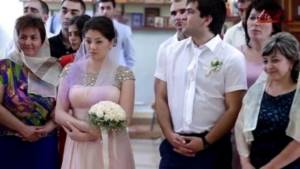
If all is well, the matchmakers come a second time. On this visit, matchmaking takes place in the presence of the young fathers, and lavash is broken in the presence of the priest. In this way, two families are united and blessed with friendship and good family relationships.
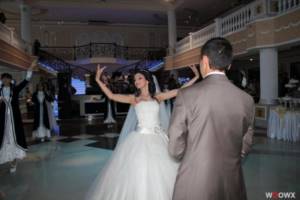
The third visit of matchmakers is called hoskap. A meeting takes place among close relatives, the bride is given gifts, and a rich table is set. Gifts are also given to the mother of the bride, usually jewelry. From this moment on, the newlyweds are considered engaged. They are not allowed to see each other before the wedding. However, with the permission and supervision of the bride's mother, the groom can visit his beloved alone. They are not allowed to touch each other.
Interesting fact: if there are several candidates for the bride’s hand, then gifts are collected from them. The one whose gift the girl chooses will become her groom.
Mars in Taurus means it's time to act: tips for each sign
Elon Musk wants to sell off his wealth to settle Mars
How to Wear an Orange Skirt Without Looking Too Colorful
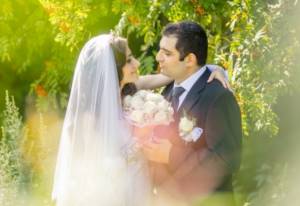
Appearance
Cloth
The traditional costume of the Yezidi Taraz is still found today in the settlements where the people live. Women wear white shalwars (hevalkras), a shirt (kras), a waist-length garment consisting of two aprons (deira), an apron (shalek), and a sleeveless vest (elak). In winter, they wear a velvet jacket (kolk), a wool belt (bane pshte), and a cone-shaped headdress trimmed with silver coins. They decorate clothes with silver belts (kamars). The Yazidis treat their traditional costume with great respect. Men wore long beards and braided hair.

Life
Previously, most of the people lived in inaccessible mountains, where the enemies of the conquerors could not penetrate. For centuries they had to defend themselves, to defend their lands. High stone fences were built around the dwellings. The Yazidis live in communities; they are divided into different clans with their own names, which were given to them by their historical ancestors.
The main activity of the Yazidis since ancient times has been cattle breeding. Mainly sheep are raised. In addition, they engage in gardening and farming. Among modern representatives of the people there are office workers, workers, representatives of the scientific, humanitarian, and technical intelligentsia who live and work in cities. Weaving and tailoring have long been developed among women. They make carpets, carpets, and various decorations for clothing.

Engagement
The engagement ceremony in Armenian culture is called nshanadrutyun. On the appointed day of engagement, guests from the groom’s side gather at his parents’ house. After a small feast, everyone goes, along with gifts for the future bride and baskets filled with fruits, sweets and wine, to her parents' house. Having arrived at the house of the groom's beloved, the guests raise baskets with treats above their heads and thus cross the threshold of the house. The bride's relatives are waiting for the guests with a set table.
According to modern custom, the table is set at the expense of the bride's parents, indicating that they are wealthy people. The bride remains in a separate room and waits for the cavor, who will lead her to the groom. When his beloved appears, the groom puts a ring on her finger. The groom's mother gives her a gold ornament, and her relatives present their gifts. This indicates that the engagement has taken place.
Relatives on both sides wish the future husband and wife a happy family life. The wedding date is set on the same day. The Armenian people have always taken the choice of a bride and the betrothal ceremony seriously. It is not customary for them to cancel it. If this happens, then such families are considered defamed. Currently, breaking an engagement is treated quite leniently.

Culture
The traditional culture of the people consists of several genres:
- songs
- prayers
- legends
- proverbs
- sayings
- beliefs
- customs
- religious ceremonies
- fairy tales
All of them reflect the age-old wisdom and national identity of the people.
Yazidi musical instruments:
- drum "daf"
- zurna
- duduk
- maya
- fic
- blur
The music consists of original melodies unique to this people. They are based on a special decrease and increase in tonality. It is worth noting the Yazidi ballads, they talk about the exploits of heroes. In culture there are labor, everyday, and wedding songs that reflect the wisdom and soul of the people.
Applied arts are present in the culture. The Yezidis are great masters of handicrafts; all products are created with a national, pronounced flavor.

Traditions
The main religious holidays celebrated by Yazidi believers:
- Aide Ezide, or the holiday of the Yazidis, is celebrated on the second Friday of December. This is the day of reconciliation; 3 days before it they keep a strict fast. You cannot eat, drink, or smoke before sunset. On Thursday evening, the laity and confessors gather at the clergy, dance, and sing religious hymns. On Friday they come to those who have recently died a loved one;
- Aide Shams, the festival of the Sun, is celebrated a week after the festival of the Yazidis;
- Khizr, or Khiryd Nabi, is celebrated in February. The holiday is named after the patron angel. He helps fulfill desires, through him the plans of fate come true. Nabi is the patron saint of lovers and reunites loving hearts. On the holiday, young people eat salty flatbreads. It is believed that after this they will see their betrothed in a dream.
- Rozhie Ezid, a three-day fast, followed by the holiday of the creation of the world in December, in February a fast in memory of the prophet Khadyr-Nabi;
- Sarsal, the New Year, is celebrated on the first Wednesday of Nisan (March-April), which is also called Charshama Sor (Red Thursday). For the holiday, Easter cakes (kloch) are prepared and eggs are painted. They are taken to the cemetery as a gift to deceased relatives, and the shells of colored eggs are sprinkled on the fields so that there is a rich harvest. On this holiday, the home should be decorated with red flowers. People go out into the street and treat the poor and their neighbors to Easter cakes. On this day it is strictly forbidden to wash, shave, cut your hair, sew, or share a bed with your spouse. After the New Year, the Yazidis celebrate the holy days (tawaf) for a whole month, which are accompanied by great rejoicing. People gather in huge round dances, dancing to the music of the zurna and drum. And the people’s year begins not in January, but in April, after the New Year.
The most important of the family traditions is the boy's first haircut, which is carried out by the sheikh "bisque".
The Yazidi wedding is very original, during which many customs are observed. The wedding is preceded by a bridesmaid ceremony (matchmaking). Previously, the bride was chosen by the parents, namely the mother. The groom himself had no right to choose. Today, young people choose their life partners on their own. According to the ancient custom, 4 people from the groom’s side come to the bride’s house for the viewing; he himself does not take part. Upon arrival, they inform the guests about the purpose of the visit; if the girl’s parents believe that it is too early for her to get married, they must give the guests a polite refusal.

To look at the girl, the guests ask her to bring water. One of them drinks very slowly to get a better look at her, while the girl must stand and wait for the guest to return the dishes to her. If the matchmakers like the future bride, they discuss the date of the next visit with her parents. When the girl's side agrees to the marriage, the groom's parents send her a valuable gift, such as a gold ring. This is a sign of successful viewing and the beginning of preparations for the wedding.
The celebration begins early in the morning at the groom's house, where musicians are called. The wedding cannot take place without them. Close relatives, friends, neighbors are invited to the holiday. Closer to lunch, everyone goes to the bride's house, where they are greeted with a festive table located in the middle of the yard. Guests from the groom's side solemnly say congratulations, drink, eat, and give gifts to the bride on special round trays (seni). They are prepared and decorated in advance. Gifts for the bride must include a beautiful wedding dress, a red shawl, alcohol, and sweets. There must be at least five trays with gifts. All gifts are accepted by relatives, guests of the bride, and given by guests, relatives of the groom, who also receive gifts. Everything takes place to cheerful music.
The groom must buy the bride's pillow; if he succeeds, the bride is released from her home, while among the Yazidis it is customary for the bride's guests to lightly hit him on the top of the head several times with the bought pillow, saying “to be together until you are old.” Then everyone goes to the groom’s house, accompanied by cheerful national music.
Rituals are prepared for the bride, during one of which she must knit two shawls on herself, one hers, the second given to her by the groom's guests. Then until the end of the holiday the bride remains with these knitted shawls. If she has a brother, he must wrap a ribbon around his sister's waist 3 times and untie it. All three nodes symbolize:
- good deed
- good intentions
- good intentions
The bride can cross the threshold of her husband's house only while the guests are performing the gowand dance. At the entrance, the groom's mother showers the newlyweds with cookies and sweets.

Afterwards, everyone enters the house, words of blessing are said, and the gifts are examined. The bride's relatives give the groom a gold ring, which the bride puts on when getting engaged. The bride's relatives show the dowry to the guests, which the groom's relatives then transport to his house. It takes quite a long time for a girl's dowry to be prepared. Everything that a young wife might need during family life applies to him. There must be a warm blanket, pillows, and bed linen.
The groom stands on a dais and places an apple on the top of his wife’s head, which is a symbol of fertility, a farewell to reproduction. Lavash is placed on the shoulders of the newlyweds, this signifies the wealth of the new family. The young people together must break the plate, simultaneously hitting it with their feet. If the dishes break after the groom hits, the first-born will be a boy; if the wife breaks the plate, a girl will be born. The newlyweds must put all the pieces together.
Before the wedding, boys and girls decorate the tree with banknotes, sweets, and fruits. The groom's witness should shake it over the newlyweds as a sign of a happy family life. During all rituals, cheerful music should be played. At a wedding, women and men sit separately. The toastmaster is required to attend the holiday, he conducts all the rituals and leads the celebration.
Yazidis always live by strict rules. A girl must maintain her virginity until marriage. If she is raped, her family disowns her, be it her daughter, sister, wife. If her family has not abandoned her, she must live her entire life in the farthest room, out of sight of strangers. If anyone sees her, they can kill her as a person who has disgraced her family. There are people who secretly rescue girls and women from captivity of ISIS fighters (an organization banned in the Russian Federation), where they are tortured, raped, and mutilated. They are returned to their families or fellow tribesmen.

Traditions of Yazidi weddings
Yazidi weddings begin very early in the morning at the groom's house. It is customary to invite musicians to his home. The newlyweds invite their best friends and people who live in the neighborhood to their celebration. The presence of the closest relatives of both parties is considered mandatory. At noon, the relatives, who automatically become the groom's confidants, go to his future wife. A table with refreshments is set up in the girl’s yard for welcome guests. They will be treated to drinks, delicious food, and desserts. When the young man's relatives reach the desired place, they say words of congratulations, drink and eat.
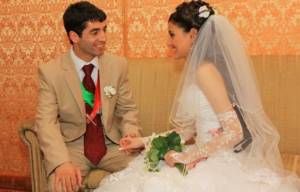
Women invited to the holiday present gifts to the bride on large round trays. Presents need to be beautifully packaged, tied with ribbons of different colors and carefully placed on trays. It is best to pack them in transparent film. There should be a total of five trays with gifts - this is considered mandatory. The gifts include two mandatory gifts. This is an elegant wedding dress for the hero of the occasion and a red shawl. Sweets, champagne and other small items are placed on other trays, which the girl’s relatives gladly take.
The bride's closest relatives deal with the gifts, while musicians play cheerful music. Then the close girls should give gifts to the groom's confidants. In order for the bride to cross the threshold of her home, relatives of both parties must dance a dance called “govand”. This is a very fun and original dance. Only after this the bride’s relatives allow guests to enter the house.
Famous people
Among the representatives of the people there are outstanding personalities whose achievements are widely known:
- Hero of the Soviet Union Samand Alievich Siyabandov;
- Teacher, director, author Arsen Rashidovich Poladov;
- National hero, commander Jangir-ara;
- Public figure Polatov Faizo Rashidovich;
- Chairman of the Yazidi Diaspora Pivazi Gocha Askarovich;
- Mixed style fighter Amar Sharifovich Suloev;
- World champion, boxer Aloyan Mikhail Surenovich.

